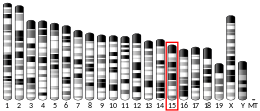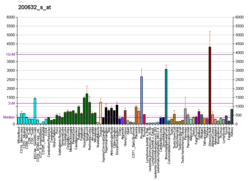NDRG1
Protein NDRG1 is a protein that in humans is encoded by the NDRG1 gene.[5][6][7][8]
This gene is a member of the N-myc downregulated gene family which belongs to the alpha/beta hydrolase superfamily. The protein encoded by this gene is a cytoplasmic protein involved in stress responses, hormone responses, cell growth, and differentiation . Mutations in this gene have been reported to be causative the autosomal-recessive version of Charcot-Marie-Tooth disease known as CMT4D.[8]
It has been reported that NDRG1 localizes to the endosomes and is a Rab4a effector involved in vesicular recycling.[9]
As reviewed by Fang et al.,[10] NDRG1 is involved in embryogenesis and development, cell growth and differentiation, lipid biosynthesis and myelination, stress responses, immunity, DNA repair and cell adhesion among other functions. NDRG1 is localised in the cytoplasm, nucleus and mitochondrion, at probabilities of 47.8%, 26.1% and 8.7%, respectively. In response to DNA damage NDRG1 translocates from the cytoplasm to the nucleus, where it may inhibit cell growth and promote DNA repair mechanisms. It is suggested that NDRG1 acts as a stress response gene or potentially as a transcription factor.
Gene
In humans, NDRG1 gene is located on the long arm of chromosome 8 (8q24.22). The gene encodes a 3.0 kilobases (kb) messenger RNA (mRNA) composed of 394 amino acids. NDRG1 belong to the NDRG1 family consisting of four members - NDRG1, NDRG2, NDRG3 and NDRG4 - that share a 53-65 % homology. In contrast to other family members, NDRG1 has a three tandem (GTRSRSHTSE) repeats in the C-terminal part.[11][12]
The expression of NDRG1 is regulated by hypoxia dependent and independent manner. Under hypoxia the oxygen sensor hypoxia-inducible factor (HIF)-1α is translocated from cytoplasma to nucleus, where binds to HIF-1β to form HIF-1 complex. This complex works as a transcription factor, binds to hypoxia response element (HRE) in the promoter of hypoxia-related genes, one of these genes is the NDGR1.[13] Also heavy metal ions (nickel, cobalt, iron) upregulate NDRG1 by mimicking hypoxia. Opposite effect on NDRG1 expression could have myc oncoproteins, N-myc and c-myc, which transcriptionally repress the expression. These effect is mediated indirectly by decreasing its promoter activity.[10]
Role in cancer
As reviewed by Kovacevic et al.,[14] NDRG1 is a potent, iron-regulated growth and metastasis suppressor that was found to be negatively correlated with cancer progression in a number of tumors, including prostate, pancreatic, breast, and colon cancers. NDRG1 has marked anti-oncogenic activity, being associated with decreased cell proliferation, migration, invasion, and angiogenesis. The molecular functions of NDRG1 affect numerous signaling pathways that regulate cancer cell proliferation, invasion, angiogenesis, and migration. Specifically, NDRG1 inhibits the oncogenic RAS, c-Src, phosphatidylinositol 3-kinase (PI3K), WNT, ROCK1/pMLC2, and nuclear factor-light chain enhancer of activated B cell (NF-B) pathways, while promoting expression of key tumor-suppressive molecules including phosphatase and tensin homolog, E-cadherin, and mothers against decapentaplegic homolog 4 (SMAD4). Through its effects on E-cadherin and beta-catenin, which form the adherens junction and promote cell adhesion, NDRG1 also inhibits the epithelial to mesenchymal transition, an initial key step in metastasis.
Functions in DNA repair and aging
In one of its functions at a molecular level, NDRG1 binds and stabilizes methyltransferases, chiefly O-6-methylguanine-DNA methyltransferase (MGMT),[15] a DNA repair protein. Thus, higher expression of NDRG1 can promote MGMT protein stability and activity. Dominick et al.[16] showed NDRG1 and MGMT protein expression was increased by 2-fold to 3-fold for each of three strains of mice (Snell, GHKRO, and PAPPA-KO) with increased longevity. These authors strongly suggest a link between the increase in the MGMT DNA repair pathway and a delay in the aging process in these mouse strains. This is consistent with the DNA damage theory of aging.
Role in immune system
The NDRG1 plays an important role in allergy and anaphylaxis, defence against bacterial pathogens and bacterial clearance, inflammation and wound healing. In mast cells, NDRG1 is upregulated during maturation and helps to rapid degranulation, which leads to enhanced exocytosis in response to various stimuli.[17] Also was shown its role in T-cell clonal anergy downstream of Egr2, where NDRG1 is upregulated in the absence of costimulation to inhibit subsequent re-activation of T cells by TCR and CD28 signalling.[18]
References
- GRCh38: Ensembl release 89: ENSG00000104419 - Ensembl, May 2017
- GRCm38: Ensembl release 89: ENSMUSG00000005125 - Ensembl, May 2017
- "Human PubMed Reference:". National Center for Biotechnology Information, U.S. National Library of Medicine.
- "Mouse PubMed Reference:". National Center for Biotechnology Information, U.S. National Library of Medicine.
- van Belzen N, Dinjens WN, Diesveld MP, Groen NA, van der Made AC, Nozawa Y, et al. (July 1997). "A novel gene which is up-regulated during colon epithelial cell differentiation and down-regulated in colorectal neoplasms". Laboratory Investigation; A Journal of Technical Methods and Pathology. 77 (1): 85–92. PMID 9251681.
- Kokame K, Kato H, Miyata T (November 1996). "Homocysteine-respondent genes in vascular endothelial cells identified by differential display analysis. GRP78/BiP and novel genes". The Journal of Biological Chemistry. 271 (47): 29659–65. doi:10.1074/jbc.271.47.29659. PMID 8939898.
- Zhang J, Chen S, Zhang W, Zhang J, Liu X, Shi H, et al. (July 2008). "Human differentiation-related gene NDRG1 is a Myc downstream-regulated gene that is repressed by Myc on the core promoter region". Gene. 417 (1–2): 5–12. doi:10.1016/j.gene.2008.03.002. PMID 18455888.
- "Entrez Gene: NDRG1 N-myc downstream regulated gene 1".
- Kachhap SK, Faith D, Qian DZ, Shabbeer S, Galloway NL, Pili R, et al. (September 2007). Heisenberg C (ed.). "The N-Myc down regulated Gene1 (NDRG1) Is a Rab4a effector involved in vesicular recycling of E-cadherin". PLOS ONE. 2 (9): e844. Bibcode:2007PLoSO...2..844K. doi:10.1371/journal.pone.0000844. PMC 1952073. PMID 17786215.

- Fang BA, Kovačević Ž, Park KC, Kalinowski DS, Jansson PJ, Lane DJ, et al. (January 2014). "Molecular functions of the iron-regulated metastasis suppressor, NDRG1, and its potential as a molecular target for cancer therapy". Biochimica et Biophysica Acta (BBA) - Reviews on Cancer. 1845 (1): 1–19. doi:10.1016/j.bbcan.2013.11.002. PMID 24269900.
- Sahni S, Park KC, Kovacevic Z, Richardson DR (June 2019). "Two mechanisms involving the autophagic and proteasomal pathways process the metastasis suppressor protein, N-myc downstream regulated gene 1". Biochimica et Biophysica Acta (BBA) - Molecular Basis of Disease. 1865 (6): 1361–1378. doi:10.1016/j.bbadis.2019.02.008. PMID 30763642.
- Sun J, Zhang D, Bae DH, Sahni S, Jansson P, Zheng Y, et al. (September 2013). "Metastasis suppressor, NDRG1, mediates its activity through signaling pathways and molecular motors". Carcinogenesis. 34 (9): 1943–54. doi:10.1093/carcin/bgt163. PMID 23671130.
- Park KC, Paluncic J, Kovacevic Z, Richardson DR (May 2019). "Pharmacological targeting and the diverse functions of the metastasis suppressor, NDRG1, in cancer". Free Radical Biology & Medicine. doi:10.1016/j.freeradbiomed.2019.05.020. PMID 31132412.
- Kovacevic Z, Menezes SV, Sahni S, Kalinowski DS, Bae DH, Lane DJ, Richardson DR (January 2016). "The Metastasis Suppressor, N-MYC Downstream-regulated Gene-1 (NDRG1), Down-regulates the ErbB Family of Receptors to Inhibit Downstream Oncogenic Signaling Pathways". The Journal of Biological Chemistry. 291 (3): 1029–52. doi:10.1074/jbc.M115.689653. PMC 4714189. PMID 26534963.
- Weiler M, Blaes J, Pusch S, Sahm F, Czabanka M, Luger S, et al. (January 2014). "mTOR target NDRG1 confers MGMT-dependent resistance to alkylating chemotherapy". Proceedings of the National Academy of Sciences of the United States of America. 111 (1): 409–14. Bibcode:2014PNAS..111..409W. doi:10.1073/pnas.1314469111. PMC 3890826. PMID 24367102.
- Dominick G, Bowman J, Li X, Miller RA, Garcia GG (February 2017). "mTOR regulates the expression of DNA damage response enzymes in long-lived Snell dwarf, GHRKO, and PAPPA-KO mice". Aging Cell. 16 (1): 52–60. doi:10.1111/acel.12525. PMC 5242303. PMID 27618784.
- Kovacevic Z, Richardson DR (December 2006). "The metastasis suppressor, Ndrg-1: a new ally in the fight against cancer". Carcinogenesis. 27 (12): 2355–66. doi:10.1093/carcin/bgl146. PMID 16920733.
- Oh YM, Park HB, Shin JH, Lee JE, Park HY, Kho DH, et al. (October 2015). "Ndrg1 is a T-cell clonal anergy factor negatively regulated by CD28 costimulation and interleukin-2". Nature Communications. 6 (1): 8698. Bibcode:2015NatCo...6.8698O. doi:10.1038/ncomms9698. PMC 4846325. PMID 26507712.
Further reading
- Kovacevic Z, Richardson DR (December 2006). "The metastasis suppressor, Ndrg-1: a new ally in the fight against cancer". Carcinogenesis. 27 (12): 2355–66. doi:10.1093/carcin/bgl146. PMID 16920733.
- Maruyama K, Sugano S (January 1994). "Oligo-capping: a simple method to replace the cap structure of eukaryotic mRNAs with oligoribonucleotides". Gene. 138 (1–2): 171–4. doi:10.1016/0378-1119(94)90802-8. PMID 8125298.
- Kalaydjieva L, Hallmayer J, Chandler D, Savov A, Nikolova A, Angelicheva D, et al. (October 1996). "Gene mapping in Gypsies identifies a novel demyelinating neuropathy on chromosome 8q24". Nature Genetics. 14 (2): 214–7. doi:10.1038/ng1096-214. PMID 8841199.
- Suzuki Y, Yoshitomo-Nakagawa K, Maruyama K, Suyama A, Sugano S (October 1997). "Construction and characterization of a full length-enriched and a 5'-end-enriched cDNA library". Gene. 200 (1–2): 149–56. doi:10.1016/S0378-1119(97)00411-3. PMID 9373149.
- Zhou D, Salnikow K, Costa M (May 1998). "Cap43, a novel gene specifically induced by Ni2+ compounds". Cancer Research. 58 (10): 2182–9. PMID 9605764.
- Kurdistani SK, Arizti P, Reimer CL, Sugrue MM, Aaronson SA, Lee SW (October 1998). "Inhibition of tumor cell growth by RTP/rit42 and its responsiveness to p53 and DNA damage". Cancer Research. 58 (19): 4439–44. PMID 9766676.
- Piquemal D, Joulia D, Balaguer P, Basset A, Marti J, Commes T (July 1999). "Differential expression of the RTP/Drg1/Ndr1 gene product in proliferating and growth arrested cells". Biochimica et Biophysica Acta (BBA) - Molecular Cell Research. 1450 (3): 364–73. doi:10.1016/S0167-4889(99)00056-7. PMID 10395947.
- Guan RJ, Ford HL, Fu Y, Li Y, Shaw LM, Pardee AB (February 2000). "Drg-1 as a differentiation-related, putative metastatic suppressor gene in human colon cancer". Cancer Research. 60 (3): 749–55. PMID 10676663.
- Kalaydjieva L, Gresham D, Gooding R, Heather L, Baas F, de Jonge R, et al. (July 2000). "N-myc downstream-regulated gene 1 is mutated in hereditary motor and sensory neuropathy-Lom". American Journal of Human Genetics. 67 (1): 47–58. doi:10.1086/302978. PMC 1287101. PMID 10831399.
- Park H, Adams MA, Lachat P, Bosman F, Pang SC, Graham CH (September 2000). "Hypoxia induces the expression of a 43-kDa protein (PROXY-1) in normal and malignant cells". Biochemical and Biophysical Research Communications. 276 (1): 321–8. doi:10.1006/bbrc.2000.3475. PMID 11006124.
- Rutherford MN, Bayly GR, Matthews BP, Okuda T, Dinjens WM, Kondoh H, LeBrun DP (March 2001). "The leukemogenic transcription factor E2a-Pbx1 induces expression of the putative N-myc and p53 target gene NDRG1 in Ba/F3 cells". Leukemia. 15 (3): 362–70. doi:10.1038/sj.leu.2402059. PMID 11237058.
- Zhou RH, Kokame K, Tsukamoto Y, Yutani C, Kato H, Miyata T (April 2001). "Characterization of the human NDRG gene family: a newly identified member, NDRG4, is specifically expressed in brain and heart". Genomics. 73 (1): 86–97. doi:10.1006/geno.2000.6496. PMID 11352569.
- Qu X, Zhai Y, Wei H, Zhang C, Xing G, Yu Y, He F (January 2002). "Characterization and expression of three novel differentiation-related genes belong to the human NDRG gene family". Molecular and Cellular Biochemistry. 229 (1–2): 35–44. doi:10.1023/A:1017934810825. PMID 11936845.
- Cangul H, Salnikow K, Yee H, Zagzag D, Commes T, Costa M (2002). "Enhanced expression of a novel protein in human cancer cells: a potential aid to cancer diagnosis". Cell Biology and Toxicology. 18 (2): 87–96. doi:10.1023/A:1015376032736. PMID 12046693.
- Cangul H, Salnikow K, Yee H, Zagzag D, Commes T, Costa M (October 2002). "Enhanced overexpression of an HIF-1/hypoxia-related protein in cancer cells". Environmental Health Perspectives. 110 Suppl 5: 783–8. doi:10.1289/ehp.02110s5783. PMC 1241245. PMID 12429530.
- Lachat P, Shaw P, Gebhard S, van Belzen N, Chaubert P, Bosman FT (November 2002). "Expression of NDRG1, a differentiation-related gene, in human tissues". Histochemistry and Cell Biology. 118 (5): 399–408. doi:10.1007/s00418-002-0460-9. PMID 12432451.
- Segawa T, Nau ME, Xu LL, Chilukuri RN, Makarem M, Zhang W, et al. (December 2002). "Androgen-induced expression of endoplasmic reticulum (ER) stress response genes in prostate cancer cells". Oncogene. 21 (57): 8749–58. doi:10.1038/sj.onc.1205992. PMID 12483528.
- Symes AJ, Eilertsen M, Millar M, Nariculam J, Freeman A, Notara M, et al. (2013). "Quantitative analysis of BTF3, HINT1, NDRG1 and ODC1 protein over-expression in human prostate cancer tissue". PLOS ONE. 8 (12): e84295. Bibcode:2013PLoSO...884295S. doi:10.1371/journal.pone.0084295. PMC 3874000. PMID 24386364.





